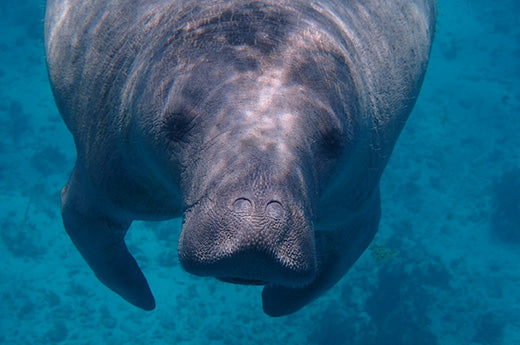Did you know that the world's oldest manatee, Snooty, died at the age of 69? Snooty lived in captivity from the time he was born at the Miami Aquarium and Tackle Company and was loved by many.
While Snooty lived to the ripe old age of 69, the manatee lifespan is usually a little shorter than that. In addition, many manatees die much earlier than they should.
Keep reading our manatee lifespan guide if you're interested in learning more about a manatee life cycle.
How Long Is the Manatee Lifespan?
When Columbus sailed the ocean blue, he spotted three "mermaids" off the coast of the Dominican Republic. He described them as, "not half as beautiful as they are painted." In addition, he stated that their faces had masculine features.
These mermaids were actually manatees. In the wild, they have the potential to live 50 to 60 years, and the manatees Columbus saw could have been young or old.
However, in captivity, manatees can live over 65 years.
What Impacts Manatee Lifespan Explained
While manatees do have the potential to live from 50 to 60 years old in their natural habit, not many do. Most manatees don't make it past the age of ten.
Just over four years ago, it was declared that manatees were no longer an endangered species. However, they are once again dying at a record pace.
Around 1,100 manatees died in Florida in 2021. So what's killing them?
Manatees have no natural predators. There are some natural causes of death for manatees. But, unfortunately, the biggest risk to the manatee population is humans.
Reproduction Rate
Manatees become sexually mature at around the age of five. When they do begin reproducing, the rate is slow, and there are dangers in the wild that need to be considered.
The gestation period for a manatee is just over a year (13 months). In addition, they only give birth every two to five years, and single deliveries are the most common.
On rare occasions, twins will be born.
Natural Causes of Death
To maintain their internal body temperature, manatees need to be in water that's no colder than 68 degrees Fahrenheit. Exposure to lower temperatures for an extended period of time puts them at risk for "cold stress."
Cold stress puts manatees at risk for disease and death. Manatees can also contract bacterial and parasitic infections that cause death.
For example, in 1996, a red tide organism, Gymnodinium breve, impacted manatees in southwest Florida. Around 150 died after they breathed or ingested the toxins.
The disease attacked their organs and caused damage which resulted in death.
Watercraft Accidents
Manatees are marine mammals and still need to surface to breathe air. They can stay underwater for as long as 15 minutes before they surface, but they need to surface every few minutes to breathe when they're swimming.
They're also incredibly slow-moving. Most only swim three to five miles per hour. However, when fleeing, they can swim as fast as 15 miles per hour in short spurts.
Because of how slowly they move and their dark color, they are at risk of collisions with watercraft. Typically, if a boater does see them, it's too late to avoid a collision.
In 2020, 593 manatees died; at least 90 of those deaths were from watercraft collisions.
Floodgates
In 2020, 11 manatees that died were killed by floodgates. Navigation locks and floodgates used to be a bigger problem.
The gates would be left partially open, and manatees would swim upstream and through the gates. This caused them to get trapped in a strong water current and ultimately drown.
In addition, flood gates that are remote-controlled can crush and drown manatees. In recent years engineers have added sensors that help prevent manatee deaths.
However, many of the gates that killed manatees in 2020 did not have these sensors. At least one death was from a manatee getting decapitated when the gates closed on them because they couldn't move out of the way fast enough.
Poaching, Habitat Destruction, and Vandalism
Manatees are legally protected. You cannot harass, feed, harm, hunt, pursue, wound, kill, shoot, annoy, or molest manatees. However, some vandals and poachers cause manatee deaths even with laws to protect them.
In some areas, manatees are hunted for food, and humans harass manatees in other areas. Another problem is the destruction of natural habitats for manatees.
As humans take over the land that once housed wildlife, it destroys the homes of these vulnerable animals.
Pollution
Did you know that there have been manatees found with fishing lines wrapped around their flippers? Accidental entanglement with fishing lines and other items can cause a serious infection, amputation, or death.
Pollution impacts the manatee population significantly. In 2017, a two-week-old manatee named Emoji was found.
He had been separated from his mother and was underweight. He also had plastic bags and debris in his stomach.
Despite the vet's best efforts, he survived only three months in captivity. Unfortunately, Emoji isn't a one-time rare story.
Many dead manatees are found with debris in their stomachs.
How Can You Help?
There are many ways you can help save manatees. You can take the steps needed to clean the ocean. You can also support conservation groups dedicated to helping support sea life and protect natural habitats and waterways.
However, one of the most important things you can do is raise awareness. There's a need for education about how our actions impact the animals around us.
Support Manatees Today
The truth about the manatee lifespan is sad. These majestic creatures deserve so much more.
You can help make this world a more positive place by showing your love. Start shopping with us today; a portion of your proceeds will go to charities like Save the Manatee Club.

